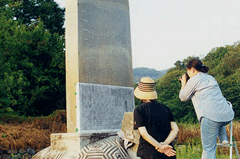Research Activities
Research of Historic Records
As many cultural items have been exposed to weathering and human damage over the years, the RDAH launched a project to study epigraphs, manuals of state rituals during the Joseon Dynasty, and other non-fixed cultural items in order to establish a preservation system to facilitate further study of them in the future.
Constructed a Comprehensive Video Database about Epitaphs
To establish the lineage and traditions of Korean designs and patterns that are used as ornamental motifs in ancient artworks, architectural edifices and stone structures, the National Research Institute of Cultural Heritage collects and surveys related data. Traditional designs and patterns, so identified, are compiledinto picture books, aimed at an academic audience, while online content developed from them, targeting a general audience, is made accessible at its official website. We have compiled a database 3,000 items including texts and image materials, and will continue to expand the related research data and discover new materials in the future. To increase the use and sharing of materials and information, we are providing services in collaboration with the Korea History Information Center and the Institute for the Translation of Korean Classics.
A photo of Survey on Epigraphic
 An archaeologist takes a rubbing of the Stele of National Preceptor Wongong at Geodonsa Temple (Treasure)
An archaeologist takes a rubbing of the Stele of National Preceptor Wongong at Geodonsa Temple (Treasure)
 Photographing Stele of National Preceptor Wongong at Geodonsa Temple
Photographing Stele of National Preceptor Wongong at Geodonsa Temple
Epigraphic Image Database
The goal of this project is the restoration and preservation of epigraphic texts through the compilation of epigraphs dating from the prehistoric times to the Joseon Dynasty into an image database, providing text images (Originals, translations, annotations, introductions and list of bibliographic references) and images (Photos and rubbings). This national-level epigraphy management project has made a tremendous contribution to research and education by enabling online access to related data, and provide learning opportunities to the general public through easy-to-understand content, specially developed for non-specialist users. A total of 2,932 kinds of epigraphic data, integrated into the database between 2002 and 2006, are accessible through the Korean Epigraphic Image System.
What is an epigraph?
ln its broad meaning, an epigraph is any written record except books, e.g., letters carved on bronze or stone are epigraphs.
Most of the epigraphs found so far are carved on stone monuments. They range from one of Korea’s most famous monuments, namely, the stone stele erected by the great King Gwanggaeto (r. 391-413) of the Goguryeo Kingdom (BC 100-668) in Jilin Province, China; the stone monuments erected by King Jinheung of the Silla Dynasty; all kinds of tombstones carved with information about the deceased’s life and achievements during the Goryeo Dynasty; commemorative monuments erected to talented civil servants during the Joseon Dynasty, and so forth.
The seven-branched knife sent as a gift to the ruler of Japan by the King of the Baekje Kingdom (BC 18-660) in Korea is a fine example of an ancient epigraph carved on iron inlaid with gold; a bowl used for ritual ceremonies during the great King Gwanggaeto’s reign with the character ho(壺) embossed on it is another example; and yet another is a statue of Buddha with a halo on which its construction date is carved.
There are also epigraphs carved on earthenware, roof tiles, pieces of wood, fabrics, lacquer wares with ink, and calligraphy on the interior walls of tombs, all of which provide important fragments of information to help us understand our history.
Study of Mobile Cultural Heritage
This project aims to survey and study movable items (e.g. paintings, sculptures, handicrafts, books), which remain undesignated as cultural heritage items, examine their value, and support those in charge of designating them as cultural heritage items. In 2007, we surveyed a total of 23 portraits of highly respected Buddhist monks. As a result, the Portrait of Buddhist Monk Samyeong in Donghwasa Temple was designated as Treasure.
In 2008, we surveyed ancient maps both in and out of the country, including Yeojido (Atlas of Korea), which is currently held by the National Library of France, and a total of 1,997 Uiin wanghu binjeon dogam uigwe (Royal Protocols on the Rites of Enshrining the Coffin and Ancestral Tablet of Queen Uiin). In 2011, we conducted a general survey of more than 400 ancient books kept by NRICH. As a result, a list of bibliographical information and introductions was published in 2012. We have also published books about three documentary paintings, including Wangseja Iphakdo (A Painting of the Crown Prince Entering School), and Taereungji (Journal about Taereung, a Royal Tomb of the Joseon Dynasty) (2012) on the basis of continued survey and research.


